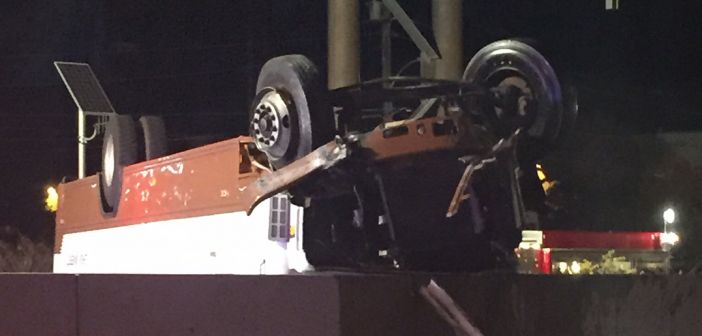After a crash that caused a bus carrying the Lehigh rowing team to roll over on U.S. Route 22, questions were raised regarding the safety features of the university’s buses. Bob Bruneio, the manager of Transportation and Transit Services, discussed Lehigh’s bus fleet with regards to numbers, organization and safety.
The university has a fleet of nine buses — 10 before the crash occurred. The fleet consists of three 48-passenger buses, similar to school buses, one of which was involved in the crash; four 50-to-60-passenger buses, referred to as transit buses; and a 28-passenger bus and a 20-passenger bus, referred to by Bruneio as little buses. In addition, the university also uses Easton Coach buses when transporting students across state lines, as the university’s transportation office is not licensed to do so.
While many are familiar with the university buses that transport athletes between Asa Packer and Goodman campuses, the transportation office works with a variety of student groups. Bruneio mentioned relationships with the Office of Fraternity and Sorority Affairs as well as specific Greek houses, club sports, Student Senate and the Office of Student Advancement, among others.
“All of our buses across the board are equipped the same, so we don’t just have athletic buses, or student buses and event buses,” Bruneio said. “Whatever the need requires we have the transportation to handle it.”
While the office works with a number of on-campus groups, Lehigh Athletics is the department that most frequently schedules bus use for student transportation. Director of Athletics Joe Sterrett discussed this relationship, as well as the recent crash, in an email to The Brown and White.
“The working relationship between athletics and transportation has been professional and effective,” Sterrett wrote. “In the 43+ years I have been on this campus, I am not aware of an accident involving a university bus that was anything like the one that occurred earlier this week. Hopefully, that is the only such experience.”
Bruneio said when choosing buses, the main priority of the transportation office is to ensure that it meets the needs and demands of the Lehigh community while adhering to the utmost of safety requirements and standards.
“Safety is always first and foremost in our department,” Bruneio said. “We wouldn’t put stuff out there that’s really not up to code or standard. We want to make sure that we get it right because you only get one shot at it.”
While not all buses come from the same company or the same place, Bruneio said all buses are equipped the same way and specific safety features are maintained.
A question that was raised following the crash was why the bus that crashed had no seat belts on board, aside from the one worn by the bus driver. Buses that weigh more than 10,000 pounds do not require seat belts on board, but sometimes transportation services elects to include them anyway.
“Our smaller bus has seat belts and the other 28-passenger bus does as well,” Bruneio said as he discussed how the university takes specific factors into consideration when purchasing buses. “There’s a waiver because it’s over 10,000 pounds, but because of the design and the nature of the buses we kept the seat belts on the bus because it’s configured and designed differently from the school bus.”
In addition to safety features of the buses themselves, Bruneio said university bus drivers are also held to strict standards. They must meet all state requirements and the university ensures all drivers have up-to-date certification. The university will not let a driver on the bus if any sort of certification, requirement or paperwork is outdated.
The bus involved in the crash is damaged and part of an ongoing police investigation, and has been taken out of commission for the university. Bruneio also addressed concerns that the out-of-commission bus would be a detriment to scheduling and transportation availability on campus, and emphasized that the office is prepared for situations like this.
“It’s going to hurt a little bit until we get it all resolved, but we certainly have a lot of resources in place,” Bruneio said. “Above and beyond we have plans for breakdowns and things like that, so although it is hurting our fleet, it’s business as usual… so no interruption of service.”
With the loss of the bus and a new bus route in the works, the university is looking into purchasing new buses, and Bruneio also discussed this process and the number of factors that go into choosing a new bus to add to the fleet.
Aside from the primary concern of safety, other important factors to consider include the needs of the community and the sizes of buses that are in highest demand: what is new and where trends are going, as well as fuel economy and how well the bus operates on gas under various conditions.
According to Bruneio, the mountain is a major factor that influences the process of choosing a bus. He has to consider if the bus is going to make it over the mountain all the time as well as longevity, whether it meets the needs of the community for a long time and holds up well with frequent travel up and over the mountain, as well as the influence of environmental conditions like snow, ice and road salt.
“We don’t just want to go out to the lot and say ‘Oh, I’ll take that one’ or ‘Oh, the price is right,'” he said. “We don’t take any chances.”






Comment policy
Comments posted to The Brown and White website are reviewed by a moderator before being approved. Incendiary speech or harassing language, including comments targeted at individuals, may be deemed unacceptable and not published. Spam and other soliciting will also be declined.
The Brown and White also reserves the right to not publish entirely anonymous comments.